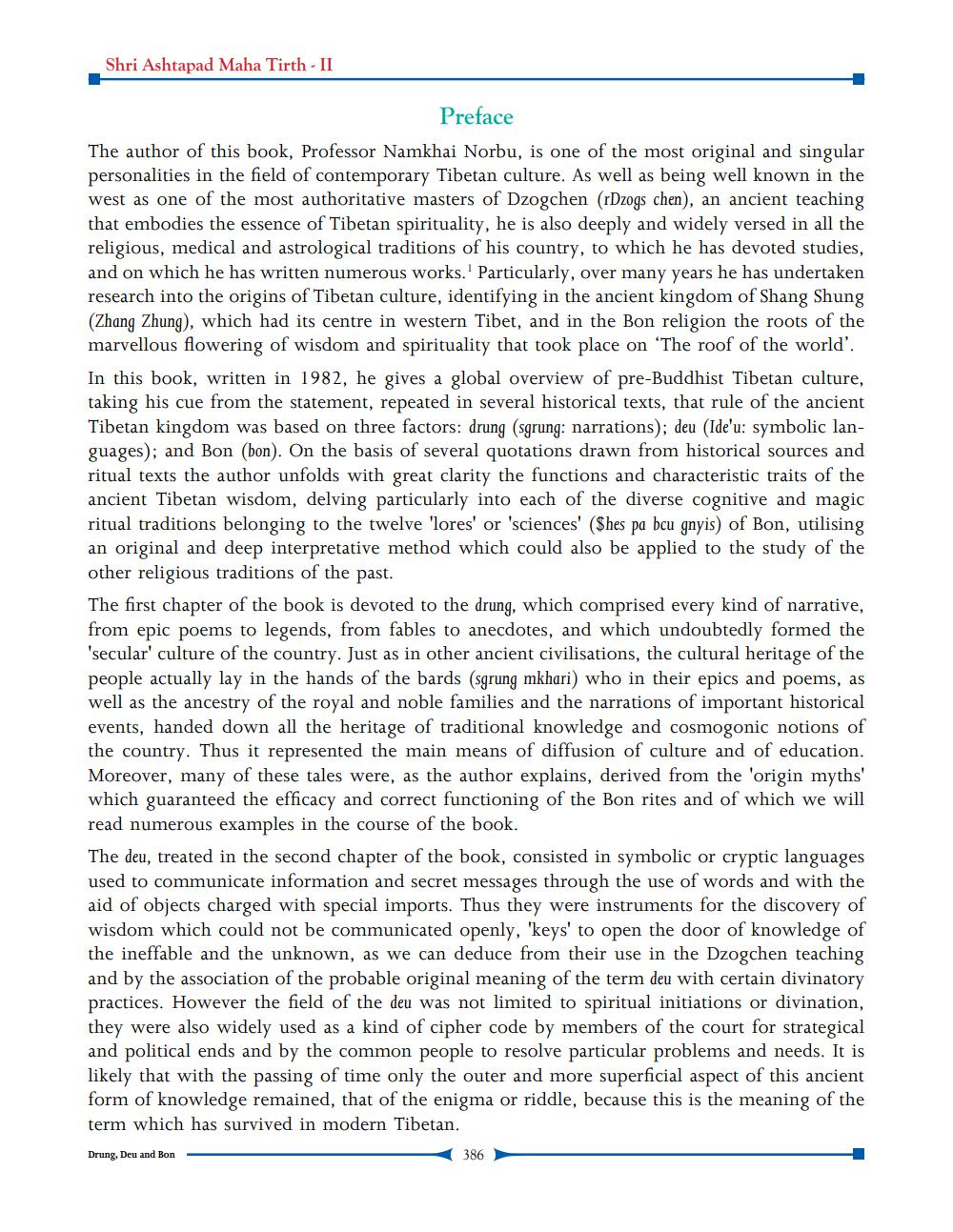________________
Shri Ashtapad Maha Tirth - II
Preface
The author of this book, Professor Namkhai Norbu, is one of the most original and singular personalities in the field of contemporary Tibetan culture. As well as being well known in the west as one of the most authoritative masters of Dzogchen (rDzogs chen), an ancient teaching that embodies the essence of Tibetan spirituality, he is also deeply and widely versed in all the religious, medical and astrological traditions of his country, to which he has devoted studies, and on which he has written numerous works. Particularly, over many years he has undertaken research into the origins of Tibetan culture, identifying in the ancient kingdom of Shang Shung (Zhang Zhung), which had its centre in western Tibet, and in the Bon religion the roots of the marvellous flowering of wisdom and spirituality that took place on "The roof of the world'. In this book, written in 1982, he gives a global overview of pre-Buddhist Tibetan culture, taking his cue from the statement, repeated in several historical texts, that rule of the ancient Tibetan kingdom was based on three factors: drung (sgrung: narrations); deu (Ide'u: symbolic languages); and Bon (bon). On the basis of several quotations drawn from historical sources and ritual texts the author unfolds with great clarity the functions and characteristic traits of the ancient Tibetan wisdom, delving particularly into each of the diverse cognitive and magic ritual traditions belonging to the twelve 'lores' or 'sciences' (Shes pa bcu gnyis) of Bon, utilising an original and deep interpretative method which could also be applied to the study of the other religious traditions of the past.
The first chapter of the book is devoted to the drung, which comprised every kind of narrative, from epic poems to legends, from fables to anecdotes, and which undoubtedly formed the 'secular' culture of the country. Just as in other ancient civilisations, the cultural heritage of the people actually lay in the hands of the bards (sgrung mkhari) who in their epics and poems, as well as the ancestry of the royal and noble families and the narrations of important historical events, handed down all the heritage of traditional knowledge and cosmogonic notions of the country. Thus it represented the main means of diffusion of culture and of education. Moreover, many of these tales were, as the author explains, derived from the 'origin myths' which guaranteed the efficacy and correct functioning of the Bon rites and of which we will read numerous examples in the course of the book.
The deu, treated in the second chapter of the book, consisted in symbolic or cryptic languages used to communicate information and secret messages through the use of words and with the aid of objects charged with special imports. Thus they were instruments for the discovery of wisdom which could not be communicated openly, 'keys' to open the door of knowledge of the ineffable and the unknown, as we can deduce from their use in the Dzogchen teaching and by the association of the probable original meaning of the term deu with certain divinatory practices. However the field of the deu was not limited to spiritual initiations or divination, they were also widely used as a kind of cipher code by members of the court for strategical and political ends and by the common people to resolve particular problems and needs. It is likely that with the passing of time only the outer and more superficial aspect of this ancient form of knowledge remained, that of the enigma or riddle, because this is the meaning of the term which has survived in modern Tibetan.
Drung, Deu and Bon
386




